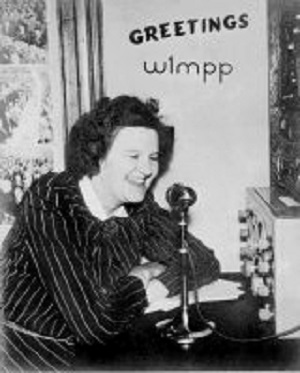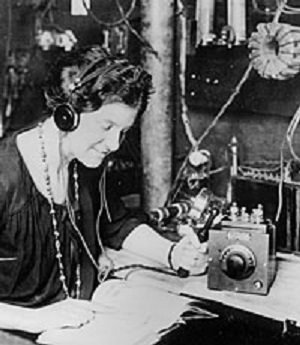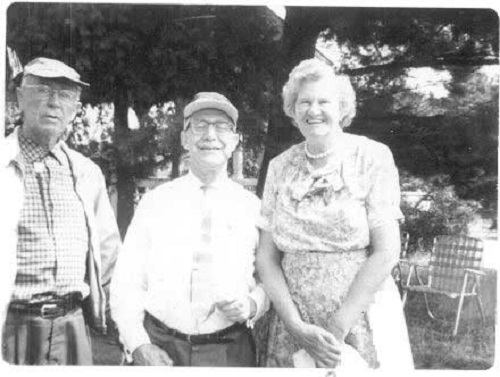 |
Eunice R. Thompson Lovell, MA QCWA # 1741 Chapter 3 OOTC # 168 Spark Op |
OM: Ken Q# 5125 K4RO
Eunice Randall Thompson W1MPP - a Radio Pioneer
Radio amateur Eunice Randall Thompson, who held call signs 1CDP then W1MPP, was recently posthumously inducted into the Massachusetts Broadcasters Hall of Fame.
Born in 1898 Eunice was raised on a Massachusetts farm on Randall Lane. She taught herself Morse Code and learned all about ham radio (or amateur radio). Her first station which she built herself, was known by her initials "ER". It was a time when you made your own call sign since radio was not regulated.
A chance encounter with another radio pioneer, Irving Vermilya, call signs 1ZE then W1ZE, led to a mentorship that helped her pick up the skills to be hired as the first female radio engineer for the American Radio and Research Company (AMRAD). In 1918 AMRAD opened a broadcast station 1XE on Medford Hillside and in 1919 Eunice became an announcer for the station.
Over the years, Eunice had a successful career as an engineer and radio expert/consultant who was active in the Eastern Massachusetts Amateur Radio Association and South Shore Amateur Radio clubs. During World War II she volunteered for the War Emergency Radio Service (WERS) and taught code to aspiring amateurs. She passed away in 1982
(Source: Southgate Amateur Radio News)
Remembering Mattapoisett's Radio Pioneer
When people think of Mattapoisett history, whaling shipbuilding normally comes to mind. However, the town has another, lesser-known distinction: the first female radio announcer in New England hailed from none other than Mattapoisett.
Eunice Randall Thompson, the aunt of former Selectman George Randall and a noted radio announcer and engineer, recently was posthumously inducted into the Massachusetts Broadcaster Hall of Fame.
This past fall, Mattapoisett residents and relatives of the late engineer, Eunice Stolecki, Cheryl Randall and Pierce Randall ventured out to Quincy, MA to attend a gala awards ceremony and luncheon that honored this woman's role in radio history.
Born in 1898, Eunice was raised on a Massachusetts farm on Randall Lane (at 29 Randall Lane, which incidentally includes the town's oldest house built in 1741) but envisioned for herself a life different than other women from her era.
She taught herself Morse Code and learned all about ham radio (or amateur radio), and a chance encounter with another radio pioneer, Irving Vermilya, led to a mentorship that helped her pick up the skills to be hired as the first female radio engineer for the AMRAD station 1XE on Medford Hillside. She later went on the air of Boston's first radio station in 1922.
Over the years, Eunice had a successful career as an engineer and radio expert/consultant who was active in the Eastern Massachusetts Amateur Radio Association and South Shore Amateur Radio clubs. During World War II she volunteered for WERS and taught code to aspiring amateurs. She passed away in 1982 in Maine, where she resided with husband Ken Thompson.
"I don't think people realize the importance of Mattapoisett in radio history," commented Donna Halper, a noted radio historian, consultant, author, university professor and radio announcer who herself broke ground as the first woman announcer at Northeastern University in Boston in the 1960s. Ms Halper has thoroughly researched the lives of Eunice and Mr Vermilya, a ham radio legend for 40 to 50 years. from Mattapoisett who passed away in 1964.
In particular, Ms Halper has worked hard to bring Eunice's contributions to radio to the public's attention. which she feels were omitted from many narratives on early broadcast history due to her gender.
But Ms. Halper's interest in Eunice is personal as well.
"I've been the first woman in every place I've been. What I really wanted to know, is who is my mother?" Ms. Halper said.
Eunice likely did not consider herself a feminist, Ms. Harper said, but "wanted to follow her own path. I don't think she believed in stereotypes". However, she "tried to change the language" of radio, especially in her insistence of bring called a "draftslady" instead of "draftsman".
As an accomplished radio engineer and announcer, "she had her foot in both worlds".
Cheryl Randall, the great niece of Eunice, remembered her as a woman of great stature (she was 6"4' tall) who taught her Braille as a child. "We'd write letters back and forth in Braille" It was really cool, "she said". Although Ms. Randall said not everyone in her family was accepting of her decision to not "stay home and have babies" - the women generally supported her.
Back in the day, Ms. Randall said Eunice built a receiver at the Randall Road home so family could listen to her broadcasts. "She ran a wire through the woods" It was pretty amazing,. she said, adding that some of the old wires are still visible on the property today.
In addition to her "engineering prowess, both Ms. Randall and Ms. Halper describe Eunice's voice as powerful. Ms. Halper said that recording technology was developed much later than Eunice's original broadcasts, thus "for the most part recollections are only through memories of those who were there". However, the Edison Company in 1937 gathered up well-known announcers for a re-enactment of their shows, offering Ms. Halper a coveted chance to hear her idol's voice.
"You can hear what an incredible voice she had: a deep rich contra alto. It was pretty amazing listening to her," said Ms. Halper - adding a footnote that in the past, the old microphones distorted voices so women's voices sounded higher and men's voices sounded lower in pitch.
"She had such a great voice, She used to sing, She was the total package". Ms. Randall said about her great-aunt. She recalled that the radio pioneer encouraged her to get her poetry published in a magazine. "She was an inspiration, I was lucky to grow up knowing her. Those were different times, and that generation is so special," she said.
Ms. Halper has a strong interest in the friendship between Eunice and Mr. Vermilya, the man who offered to teach her after randomly picking up her amateur Morse coded messages at his home two towns away around 1918. He had responded in code, "Your daddy didn't teach you right, little boy". After responding, Eunice had added, "And by the way, I'm not a little boy, I'm a girl". From that point, Mr. Vermilya offered to teach her more about ham radio and the two became lifetime friends.
"Talk about chance in bringing two people together," Ms. Halper commented. "Eunice was a true friend to him".
Of the two personalities from Mattapoisett who shaped radio, she said, "Their stories are so important to the people who created my industry".
(Source: www.wanderer.com, January 2012)
Eunice Randall-- Boston´s first female announcer/engineer
by Donna Halper
If you had been around greater Boston during the 19-teens and early 20s, you might have heard Eunice Randall referred to as "ER," since radio announcers were not usually allowed to use their names on the air. To her ham radio friends, she was "the OW of 1XE," or "1CDP;" to some of her youngest fans, she was "the Story Lady." Eunice Randall was all of this and more-although she was born in an era when women´s options were still extremely limited, she grew up to achieve a number of ´firsts´ in the exciting new industry called radio broadcasting.
In the early 1900s, Mattapoisett (a town in southeastern Massachusetts) was still rural, and Eunice´s father was a farmer, while one of her brothers ran a mill. As far as I have been able to ascertain, there were no ´radio bugs´ in her family, and yet somehow she became fascinated by the rapidly-expanding world of ham radio. Her first station, which she built herself, was called "ER", and her technical skills impressed one of the men who received the code she was sending out-- he was the regional director of the ARRL, Irv Vermilya, a man who was very influential in amateur radio.
Irv was surprised that a young woman could build her own station, but he was also immediately supportive; he was the first to write about her radio skills, in the ham magazine, QST.
Not content to stay on her family´s farm, Eunice moved up to Boston, with the plan to study art. But she found that she was good at drafting, and when she heard that the American Radio and Research Company needed draftsmen, she applied; in 1918, she became the first woman AMRAD ever hired. I would be lying if I said everyone welcomed her with open arms-- it was highly unusual for women to work in technical professions back then.
And while some women worked as receptionists or confidential secretaries, Eunice Randall was not typical of her generation: not only was she an experienced ham radio operator but she now wanted to work with the men building radio receivers. Needless to say, she underwent considerable hazing in the factory-- what would today be called sexual harrassment-- but gradually she won everyone over, because her drafting work was very precise and she wasn´t afraid to learn new jobs.
AMRAD had opened a broadcasting station in 1916; it was mainly operated by Tufts College students (AMRAD´s founder, Harold J. Power, was a Tufts alumnus), but now that the AMRAD factory was expanding, some of the non-student workers also took their turn keeping the station on the air. Among them was Eunice Randall. All the amateur stations were taken off the air during World War 1, but as soon as it was legal to do so, the AMRAD station (known legally as 1XE, but referred to in the newspapers as "The Amrad station" or "the Medford Hillside station") resumed its broadcasts.
At some point in 1919, Eunice Randall became an announcer for the station, the first woman on air in greater Boston. By 1921, she was not only helping with the engineering, doing announcing, and at times sending out code so that any amateurs listening could get some code practise-- she had also gotten a sponsor and was now the "Story Lady". At least three nights a week, she read bed-time stories to the kids, sponsored by Little Folks Magazine. (In QST, and even in some of the newspapers, she was still referred to as the "OW of 1XE"-- "OW" being an affectionate term for a female amateur.)
In February of 1922, 1XE received its license from the Department of Commerce and was assigned the call letters WGI. Eunice remained in her dual roles of AMRAD factory draftsman and WGI announcer. When the factory needed her more, she spent more time there; when the radio station beckoned, she did that-- in fact, when a guest didn´t show up, she and another of the engineers sang duets! The newspapers referred to her the "Radio Mother" because her bed-time stories were very popular with kids all over New England. (The idea of radio bed-time stories was still very new, as were most of the things WGI had been doing. Unfortunately, the station operated on a shoe-string, and seldom got the publicity it deserved.) She represented AMRAD at several radio shows, and it certainly must have encouraged other young women to see her demonstrating equipment and doing broadcasts.
As for the men who heard Eunice speak and saw some of her radio work, they included Hiram P. Maxim, whom she met when she demonstrated one of AMRAD´s newest radio tubes at a convention in Portland, Maine in late 1921. (In the early 20s, she was one of a very few women who were licensed radio operators-- some reports say she was the only one in New England.) Irv Vermilya, with whom she remained friends for many years, continued to write favourably in QST and elsewhere about her work; this certainly must have helped her to achieve even more credibility. Over the years, the two would sometimes attend hamfests together and compete in code-sending contests. (Eunice could even do ´foot-sending´, and she was quite proficient at it!)
Unfortunately, Eunice Randall´s radio career was cut short by the fact that WGI and its parent company AMRAD ultimately went bankrupt. The station left the air in the spring of 1925, never to return. Everyone who had worked so hard to keep the station up and running ended up in various other places. Some, like "Big Brother" Bob Emery, would become famous at another station and have a long radio career; others left radio and never went back to it-Eunice was one of those. She continued to work as one of the few women engineers, however, and she also continued her involvement with ham radio (her calls were 1CDP and later, W1MPP). During World War 2, she and a number of other amateurs did volunteer work as part of the WERS, and over the years, she taught many young amateurs what they needed to know to get their license. Eunice and her husband, Ken Thompson, a former AMRAD employee, moved up to Maine after she retired. She died in 1982.
Ever since I began researching the saga of 1XE/WGI and became familiar with this amazing woman, I have wanted to tell her story. My thanks to Barry Mishkind for giving me the opportunity.
(www.oldradio.com)
Eunice Randall (1898 - 1982)
1CDP and W1MPP
Around 19 years of age, Eunice Randall built her own amateur radio station (ER). In 1919, Eunice became the first announcer, on-air, at AMRAD (1XE/WGI), broadcasting station, in Boston, Massachusetts. Male colleagues strongly opposed hiring Eunice. With a team of engineer/radio experts, she demonstrated, built and tested equipment. To keep the company's radio station on-air, this six-foot lady, climbed the tower, when necessary, earning their respect.
In 1925, AMRAD went bankrupt and shut down. Eunice still continued working as an engineer and an active YL in amateur radio activities. She married to Ken Thompson (W1PS), in 1948, an employee of AMRAD. Their retirement years were spent in Maine, where Eunice Randall Thompson died in 1982.
(www.qsl.net)
CREDITS
Photo #1: hamgallery.com - Tom Roscoe K8CX, Robert Ballantine W8SU
. October 5, 1898 (MA)-March 24, 1982 (Orange City, FL)
. OM is George Kenneth "Ken" Thompson, K4RO (ex-W1PS, 2PL); married October 12, 1948
. They retired to Lovell and Fryeburg, ME, then to Orange City, FL
. OOTC# 168; Ken (#230) and Eunice were first OOTC married couple
. Eunice began work at the New England Power Company in 1929, remaining until 1961

Source: Massachusetts Broadcasters Hall of Fame (1921 pic)

Source: www.hamelectronics.com (L-R: W1PS (Ken), VE2TA, W1MPP (Eunice) in 1960s)